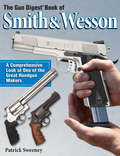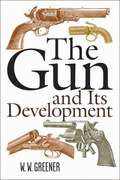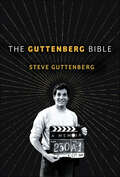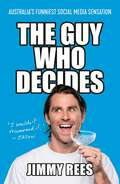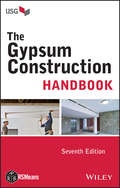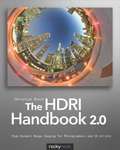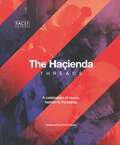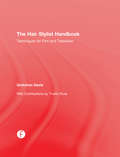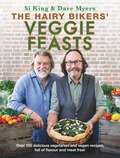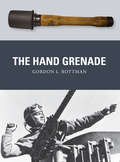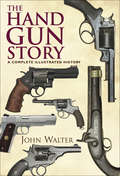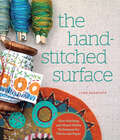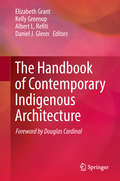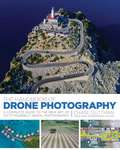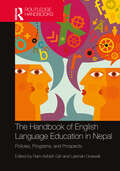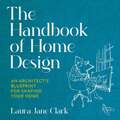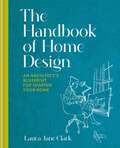- Table View
- List View
The Gun Digest Book of Smith & Wesson
by Patrick SweeneyAuthor Patrick Sweeney leads readers through Smith & Wesson's dizzying array of handgun models and options. From plinking revolvers to the new .500 S&W hand cannon, Sweeney reviews S&W models inside and out for performance, function and versatility, letting the reader known which models will work best for self-defense, hunting or target shooting. With information on basic troubleshooting, testing used guns for reliability and reviews of specific models from every major S&W group, The Gun Digest Book of Smith & Wesson gives readers an accurate overview of the offerings of this fine American gunmaker.
The Gun Digest Buyers' Guide to Guns
by Ken RamageFor many gun owners, the story is the same - so many guns to choose from, and so little time (and possibly patience) to review all the various reference needed to get the full picture of modern-era market. This new Gun Digest guide helps readers make the most of research time, without loosing any reliability, by coupling authoritative reports on the latest handguns, rifles and shotguns and 3,500+ photographs, with distinct catalogs of modern commercial arms and used guns with realistic prices.
The Gun and Its Development (Greenhill Military Paperback Ser.)
by W. W. GreenerFirst published in Great Britain in 1881 and subsequently revised nine times between then and 1910, The Gun and Its Development traces the fascinating history of weaponry: the obscure, ancient origins of the slingshot and the bow, the invention of the crossbow, possibly around 1000 AD; the introduction of gunpowder into Europe in the fourteenth century; the development of sporting and military guns over the centuries thereafter; and the rise of modern, mass-produced firearms in the early twentieth century.Chapters cover early to modern handguns; gunpowder ignition methods from fuses and flintlocks to percussion fulminates; shotguns; hammerless guns; ejector guns; the history of the firearms industry; manufacturing methods and their development in Britain, America, and elsewhere; how to use and handle different types of guns; ballistics; the development of rifling and smokeless powder; and much more. Copiously illustrated with photographs and marvelous engravings, The Gun and Its Development is the classic, authoritative reference work on the subject, certain to be of great interest to marksmen, hunters, gun collectors, and anyone interested in military or industrial history.
The Guttenberg Bible: A Memoir
by Steve Guttenberg"Forget being an actor. You don't have the look, you don't have the talent, and your name is ridiculous. You are the last guy I would ever pick to be a movie star." This was the first piece of advice Steve Guttenberg ever received from an agent. Like many other times in his life, he didn't listen.In this honest, charming memoir, Guttenberg tells the unique story of his first decade in Hollywood, as he went from being a complete unknown to starring in some of the most successful blockbusters of all time. He spent his early days sneaking onto the Paramount lot and meeting more actors and casting agents than most aspiring actors ever would. Even before the hit Police Academy---which his manager said would be a flop---he had already worked with such luminaries as Lord Laurence Olivier, Richard Widmark, and Gregory Peck. Later he shared the screen with actors such as Mickey Rourke and Sharon Stone long before they became household names.Guttenberg has lived through the addictive pull of show business and worldwide celebrity (you're no one until you have a stalker, he learns). With a clear-eyed appreciation for the one-of-a-kind experiences that the celebrity lifestyle has to offer, he knew that his family would keep him grounded throughout it all. And his self-awareness and sense of humor about the ups and downs of fame make The Guttenberg Bible one of the most candid Hollywood stories to date.
The Guy Who Decides: Australia's funniest social media sensation
by Jimmy ReesHave you ever wondered who made the call on imperial measurements, collective nouns for animals, horoscopes and Olympic sports? What were they thinking? And why do parents insist on naming their children after cities, cars and smoothie ingredients (Paris, Mercedes and Kale, we're looking at you...)?The Guy Who Decides, Jimmy's first book for adult readers, expands upon his hilarious videos lampooning the absurd conventions and rules of our modern world through the outlandish characters of The Guy Who Decides (who appears to be several martinis deep at all times) and his underling, Jason. Meanwhile, from Brighton to Byron Bay and beyond, prepare to meet a bunch of Australians who are as funny/scary as they are uproariously familiar!
The Guy Who Decides: Australia's funniest social media sensation
by Jimmy ReesHave you ever wondered who made the call on imperial measurements, collective nouns for animals, horoscopes and Olympic sports? What were they thinking? And why do parents insist on naming their children after cities, cars and smoothie ingredients (Paris, Mercedes and Kale, we're looking at you...)?The Guy Who Decides, Jimmy's first book for adult readers, expands upon his hilarious videos lampooning the absurd conventions and rules of our modern world through the outlandish characters of The Guy Who Decides (who appears to be several martinis deep at all times) and his underling, Jason. Meanwhile, from Brighton to Byron Bay and beyond, prepare to meet a bunch of Australians who are as funny/scary as they are uproariously familiar!
The Gypsum Construction Handbook (RSMeans)
by USGThe tried-and-true Gypsum Construction Handbook is a systematic guide to selecting and using gypsum drywall, veneer plaster, tile backers, ceilings, and conventional plaster building materials. A widely respected training text for aspiring architects and engineers, the book provides detailed product information and efficient installation methodology. The Seventh Edition features updates in gypsum products, including ultralight panels, glass-mat panels, paperfaced plastic bead, and ultralightweight joint compound, and modern specialty acoustical and ceiling product guidelines. This comprehensive reference also incorporates the latest in sustainable products.
The HDRI Handbook 2.0
by Christian BlochHigh dynamic range imaging (HDRI) takes photography to a whole new level. It opens the door to unprecedented creative freedom in digital post-processing by capturing everything from the darkest shadows to the brightest highlights. HDRI means truly lossless image editing, full exposure control, and the ability to master any scene's contrast without artificial lighting and preserve all light from a scene so it can be digitally revisited anytime in the future. Combined with panoramic photography, this captured light can even be used to render 3D objects with a deceivingly realistic appearance. In 2007, The HDRI Handbook was the first book to present this revolutionary new field to a larger audience. These days HDRI is a fully mature technology available to everyone. Real estate and landscape photographers have adopted it as part of their regular workflow, it has become one of the hottest trends for ambitious amateurs and creative professionals alike, and the modern movie industry would be completely dysfunctional without it. Now The HDRI Handbook 2. 0 redefines its own gold standard. It has been completely rewritten and is packed with practical hints and tips, background knowledge, reference tools, breathtaking artist portfolios, and inspiring interviews. The book includes dozens of new step-by-step tutorials, which are easy to follow with the material provided on the DVD. Beginners will get a methodically solid introduction and advanced readers will be able to refine their technique to perfection. Whether you are a photographer, CG artist, compositor, or cinematographer, this book is sure to enlighten you. Topics include: Understanding the foundation of HDRI HDR software comparisons and evaluations Capturing HDR images: today and tomorrow Tonemapping for creating superior prints HDR image processing and compositing Shooting and stitching HDR panoramas Image-based lighting and CG rendering 2. 0 updates include: New cameras, sensors, and HDR beamsplitter rigs Open Camera Controller for endless auto-bracketing Correct RAW pre-processing and ghost removal Dozens of practical, easy-to-follow tutorials A structured approach to tonemapping, inspired by Ansel Adams Set etiquette and tips for capturing HDR panos for visual effects Seven artist spotlights showing unique perspectives on HDRI Seven crossword puzzles: a fun way to test yourself A companion DVD loaded with goodies
The Hacienda: Foreword by Peter Hook
by Rebecca HookFOREWORD BY PETER HOOKThe music. The fashion. The nights. The people. The love. These are the threads that came together to make the Haçienda great.Celebrate the magic of the club that changed everything in this official book, told through evocative photographs and eye-witness accounts of the people who were there, from musicians, DJs and fashion designers to performers, clubbers and staff.Featuring contributions from Peter Hook, John Cooper Clarke, Bez, Rowetta, Mani, Noel Gallagher, Irvine Welsh, Andrew O'Hagan, Mike Pickering, DJ Paulette, Todd Terry and Roger Sanchez - as well as Haçienda staff, club-goers and many more.
The Hacienda: Foreword by Peter Hook
by Rebecca HookFOREWORD BY PETER HOOKThe music. The fashion. The nights. The people. The love. These are the threads that came together to make the Haçienda great.Celebrate the magic of the club that changed everything in this official book, told through evocative photographs and eye-witness accounts of the people who were there, from musicians, DJs and fashion designers to performers, clubbers and staff.Featuring contributions from Peter Hook, John Cooper Clarke, Bez, Rowetta, Mani, Noel Gallagher, Irvine Welsh, Andrew O'Hagan, Mike Pickering, DJ Paulette, Todd Terry and Roger Sanchez - as well as Haçienda staff, club-goers and many more.
The Hair Stylist Handbook: Techniques for Film and Television
by Gretchen DavisAchieve professional quality hair results with this full-color, comprehensive book from award-winning hair and makeup pros, Gretchen Davis and Yvette Rivas. In The Hair Stylist Handbook: Techniques for Film and Television, you’ll learn how to create that sought-after "complete look" by learning the newest hair techniques that are in demand on film and television sets. Learn how to break into the industry, what products to use to achieve specific effects, how to maintain a look throughout the day, what quick techniques to use to achieve certain textures, and much more. With input from hairstylist Yvette Rivas, this step-by-step guide makes complex techniques clear, allowing you to achieve the most coveted results. In this informative handbook you will find: An extensive chapter on men’s grooming techniques and hair products Specific techniques for dramatic and long lasting hair color Lists of the best hair tools and instructions for how to use them to achieve different looks Information about how production schedules, cast, and crew are all affected and influenced by the hair and makeup team Details on how to run a successful and organized hair and makeup trailer on set Whether you are a professional in the field, or a student looking to break in to the industry, this book will provide you with secrets and information that you cannot find anywhere else.
The Hairy Bikers' Veggie Feasts: Over 100 delicious vegetarian and vegan recipes, full of flavour and meat free!
by Hairy BikersTHE IRRESISTIBLE NEW SUNDAY TIMES BESTSELLER.At last, vegetarian and vegan food Bikers' style! In this brand-new collection of down-to-earth yet satisfying meat-free dishes, Si and Dave have gathered together their most hearty and warming comfort food ... thatjust happen to be vegetarian! Triple tested, with maximum taste and minimum fuss, these recipes are simply epic.Si and Dave have been on a mission. They've travelled the world to discover the very best meat-free recipes that shake off the dull and add the delicious. There's no meaty sacrifice here, just fantastic food.From the ultimate veggie curries to the perfect crowd-pleasing tray bakes, satisfying soups, pastas and pies to a veggie twist on burgers, barbecues and a banging breakfast brunch, The Hairy Bikers' Veggie Feasts is bursting with meat-free delights you'll turn to time and time again, all made with ingredients that can be bought easily and won't cost the earth.With savoury favourites like Chilli Bean Bake and Indian Shepherd's Pie, snacks including Pickled Onion Bhajis and Cheese and Marmite Scones, and sweet treats like Jammy Dodgers and the ultimate Chocolate Brownies, this new cookbook will be your meat-free bible.Si and Dave have made it even easier - and more delicious - to eat meat free. These recipes are a real turnip for the books ... so get cooking and enjoy.
The Hall: A Celebration of Baseball's Greats
by Tom Brokaw The National Baseball Hall of Fame and MuseumA deluxe baseball treasury unlike any other, complete with essays, photos, and player bios from The National Baseball Hall of Fame and Museum.Everyone dreams of Cooperstown. It's a hallowed name in baseball, for players as well as their fans. It's a house where legends live; it's everything that's great about the game. Never before has the National Baseball Hall of Fame and Museum published a complete registry of inductees with plaques, photographs, and extended biographies. In this unique, 75th anniversary edition, read the stories of every player inducted into the Hall, organized by position. Each section begins with an original essay by a living Hall of Famer who played that position: Hank Aaron, George Brett, Orlando Cepeda, Carlton Fisk, Tommy Lasorda, Joe Morgan, Jim Rice, Cal Ripken Jr., Nolan Ryan, and Robin Yount.
The Hamburg Dramaturgy by G.E. Lessing: A New and Complete Annotated English Translation
by Natalya BaldygaWhile eighteenth-century playwright and critic Gotthold Ephraim Lessing made numerous contributions in his lifetime to the theater, the text that best documents his dynamic and shifting views on dramatic theory is also that which continues to resonate with later generations – the Hamburg Dramaturgy (Hamburgische Dramaturgie, 1767–69). This collection of 104 short essays represents one of the eighteenth century’s most important critical engagements with the theater and its potential to promote humanistic discourse. Lessing’s essays are an immensely erudite, deeply engaged, witty, ironic, and occasionally scathing investigation of European theatrical culture, bolstered by deep analysis of Aristotelian dramatic theory and utopian visions of theater as a vehicle for human connection. This is the first complete English translation of Lessing's text, with extensive annotations that place the work in its historical context. For the first time, English-language readers can trace primary source references and link Lessing’s observations on drama, theory, and performance not only to the plays he discusses, but also to dramatic criticism and acting theory. This volume also includes three introductory essays that situate Lessing’s work both within his historical time period and in terms of his influence on Enlightenment and post-Enlightenment theater and criticism. The newly translated Hamburg Dramaturgy will speak to dramaturgs, directors, and humanities scholars who see theater not only for entertainment, but also for philosophical and political debate.
The Hand Grenade
by Gordon L. RottmanThe Hand Grenade is the dramatic story, covering its origins, development, use - in the World Wars and into the present day - and lasting influence on close-quarter combat and infantry tactics.Allowing the user to inflict damage on his opponent within throwing range without leaving cover, the portable, lethally efficient hand grenade is a ubiquitous weapon of modern warfare, and has now found its way into law-enforcement arsenals too. In this engaging study the origins, development, combat use and lasting legacy of the military hand grenade are explored and assessed, accompanied by specially commissioned full-color artwork and an array of revealing photographs of grenades in use and in close-up.
The Hand Gun Story: A Complete Illustrated History
by John WalterA firearms expert &“traces the history of the &‘one hand gun&’ from its 14th century origins . . . surveying changing technology, techniques, and design&” (Midwest Book Review). Ideally suited for both attack and self-defense, handguns have gotten smaller and deadlier. But the earliest pistols had a tendency to misfire. This was cured by the cap-lock, which proved a massive success in the American Civil War, with hundreds of thousands of cap-lock revolvers used on each side. Self-contained metal-case cartridges were to bring a fundamental change to handgun design: not only by allowing the introduction of revolvers that ejected automatically or were easily reloaded, but also by paving the way for the automatic pistol. World War I provided the handgun with a proving ground. At the end of the hostilities, with so much surplus weaponry, work on the handgun could have ceased; instead, a new developmental phase was begun by the nations that had emerged from the crumbling Imperial empires. During World War II, the efficiency of well-established designs was confirmed and new designs, such as the Walther P. 38, showed their potential. The emergence of the submachine-gun in 1945 reduced the status of the handgun—but only temporarily. The need for efficient self-defense shows no signs of lessening; and the rise in shooting for sport, particularly with the revolver, has sharpened the quest for efficiency. The never ending search for advanced production techniques shows that the handgun has as much a future in the twenty-first century as it had in the heyday of the Wild West, or in the trenches of Passchendaele.
The Hand-Stitched Surface: Slow Stitching and Mixed-Media Techniques for Fabric and Paper
by Lynn Krawczyk“Improvisational hand-stitching lies at the heart of Krawczyk’s collection of embroidery projects . . . The overall style is loose and free-wheeling.” —Library JournalAdd new color and flair to your home with hand-stitching projects! Written by noted surface designer Lynn Krawczyk, The Hand-Stitched Surface offers inspiring techniques and beautiful projects for creating richly layered mixed-media surfaces on paper and fabric. It’s a fast world we live in; it’s important to remember to slow down and savor your handiwork, and hand-stitching is the perfect craft for that.After Krawczyk gives you an overview of tools and supplies you’ll be using, she will move you into a section on stitching essentials which covers a range of basic stitches and how they can be modified.You will learn the following skills: Mixing thread weights for textural effectsUnique ways to create patterns for hand stitchingExploring colorTips and tricks for improvisational stitchingAnd much more! The fifteen keepsake-quality projects are perfect for the times when you feel you need to disconnect from the modern world and enjoy a quieter, more meditative hobby.“Delightful.” —The Papercraft Post
The Handbook of Bird Photography
by Bence Mate Jari Peltomaki Markus VaresvuoThe Handbook of Bird Photography distills the knowledge, talent, and experience of three well-known professional wildlife photographers into one beautifully illustrated volume. Written in a manner that is easy to understand, this book offers fresh insight and practical tips that will broaden horizons for nature and bird photographers. The authors share their stories showcasing photographs for which they have received awards in major international wildlife photo competitions. In this book, you'll learn about all of the elements that lead to a great bird photograph, including:The bird photographer's equipment Shooting techniques: exposure, focus, how to show movement and freeze action, etc. In the field: bird behavior, hides, and how to attract birds How to use light and compose and crop images The best sites for finding and photographing birds You'll also learn how to show, share, promote, and sell your photographs. Bird photography is a brilliant way to spend your free time, and for some it's a career. This book helps beginners get the hang of things quickly and accurately, and offers field-specific expertise for more experienced photographers.
The Handbook of Community Safety Gender and Violence Prevention: Practical Planning Tools
by Carolyn WhitzmanViolence and insecurity are among the most important issues facing communities in the 21st century. Both family violence and community violence are rapidly rising in the urbanizing nations of theSouth and richer nations are also facing increased concern about the health, social, economic and environmental costs of violence and crime. The Handbook of Community Safety, Gender and Violence Prevention is the first book to gather together research and examples, from a gendered perspective, of local, regional and international interventions that work to prevent crime, violence and insecurity. Case studies of successful initiatives from every continent, in settings that vary from large cities to rural areas, are analysed to provide cross-cultural lessons of what works and what doesn t. The book presents essential practical advice to professionals such as: how to obtain diagnostic information on incidence and impacts of violence; how to develop, maintain and evaluate policies and programmes that can effectively promote community safety; and how to create trust and effectiveness in partnerships.
The Handbook of Contemporary Indigenous Architecture
by Kelly Greenop Elizabeth Grant Albert L. Refiti Daniel J. GlennThis Handbook provides the first comprehensive international overview of significant contemporary Indigenous architecture, practice, and discourse, showcasing established and emerging Indigenous authors and practitioners from Australia, Aotearoa New Zealand, the Pacific Islands, Canada, USA and other countries. It captures the breadth and depth of contemporary work in the field, establishes the historical and present context of the work, and highlights important future directions for research and practice. The topics covered include Indigenous placemaking, identity, cultural regeneration and Indigenous knowledges. The book brings together eminent and emerging scholars and practitioners to discuss and compare major projects and design approaches, to reflect on the main issues and debates, while enhancing theoretical understandings of contemporary Indigenous architecture.The book is an indispensable resource for scholars, students, policy makers, and other professionals seeking to understand the ways in which Indigenous people have a built tradition or aspire to translate their cultures into the built environment. It is also an essential reference for academics and practitioners working in the field of the built environment, who need up-to-date knowledge of current practices and discourse on Indigenous peoples and their architecture.
The Handbook of Drone Photography: A Complete Guide to the New Art of Do-It-Yourself Aerial Photography
by Chase GuttmanDrones are the next frontier in photography. This cutting-edge technology, still unexplored by the masses, can bring visual artistry to new and exciting heights. The Handbook of Drone Photography will be the go-to manual for consumers wishing to harness the power of drones to capture stunning aerial photographs.This book covers everything one needs to choose the right drone, to get airborne, and to capture and share incredible content. With easy and straightforward instruction, the text will familiarize readers with their craft and its controls. Readers will master drones’ extraordinary image-capturing capabilities and review detailed photography tips that can bring their artistic vision to life. For the first time, aerial photography is open to everyone, and award-winning travel photographer Chase Guttman will guide readers’ drone ventures from beginning to end. The Handbook of Drone Photography can help anyone break into this thrilling, high-potential space and launch their own lofty explorations today.
The Handbook of English Language Education in Nepal: Policies, Programs, and Prospects
by Ram Ashish Giri and Laxman GnawaliThis book takes an interdisciplinary approach to explore wide-ranging topics from applied linguistics, education, sociology, political science, and cultural studies. It presents a comprehensive overview of English language education since its importation to Nepal.This volume covers English language education (ELE) politics and policy, theories and pedagogies, English as a medium of instruction, English teachers’ professional development, multilingualism and linguistic ecology, perspectives on equity, diversity and inclusion, as well as ELT and technology. Comprising scholarly discussions on emerging ELE issues in contemporary Nepal, the chapters explore various aspects of theoretical, and pedagogical considerations of ELE. While delving into the growing future of English in Nepal, it also presents analytical case studies of its controversial present and past practices. It sheds light on its development, shifting paradigms and present state of affairs, as well as the status of English in conjunction with the national language, Nepali and other Indigenous languages.This book will be useful to students, researchers and teachers of education, linguistics, and teacher training institutions. It will be an essential read for those involved in English language education, applied linguistics, EIL/WE/ELF, ESL/TESOL/ELT and TEFL, as well as for teachers, teacher educators, teacher trainees and international aid organisations.
The Handbook of Home Design: An Architect’s Blueprint for Shaping your Home
by Laura Jane ClarkArchitectural solutions & designs to optimize the spaces in your home without spending a fortune.Architect Laura Jane Clark, from the BBC and Netflix smash-hit series Your Home Made Perfect, has spent over 15 years designing, remodelling, and building homes with budgets that range from modest to enormous. THE HANDBOOK OF HOME DESIGN distils Laura's wealth of experience and enthusiasm giving you an accessible yet detailed guide to design, empowering you with the tools and knowledge to shape your home how you want. Throughout your home design journey, whether large or small, Laura takes you each step of the way from understanding your home, reading a plan and writing a brief, right through to sketching your own design and having the confidence to get what you want on the building site. Packed full of tips and tricks, inspiration and technical know-how, THE HANDBOOK OF HOME DESIGN is like having Laura by your side, showing you how to design practical yet beautiful spaces, get more storage into your life and create the home of your dreams.Laura Jane Clark wants to democratize the whole concept of residential architectural design and empower you to redesign your spaces by giving you the language and ability to confidently communicate your vision, get the most out of your design and ultimately love your finished home. Whether you are a long-term homeowner, first-time buyer or simply visualising your dream space, no matter what your budget is, this unique insight into Laura's process allows you to achieve both the design you want and the home you need.www.lamparchitects.co.uk Instagram: @laurajaneclark_(p) 2023 Octopus Publishing Group
The Handbook of Home Design: An Architect’s Blueprint for Shaping your Home
by Laura Jane ClarkArchitectural solutions & designs to optimize the spaces in your home without spending a fortune.Architect Laura Jane Clark, from the BBC and Netflix smash-hit series Your Home Made Perfect, has spent over 15 years designing, remodelling, and building homes with budgets that range from modest to enormous. THE HANDBOOK OF HOME DESIGN distils Laura's wealth of experience and enthusiasm giving you an accessible yet detailed guide to design, empowering you with the tools and knowledge to shape your home how you want. Throughout your home design journey, whether large or small, Laura takes you each step of the way from understanding your home, reading a plan and writing a brief, right through to sketching your own design and having the confidence to get what you want on the building site. Packed full of tips and tricks, inspiration and technical know-how, THE HANDBOOK OF HOME DESIGN is like having Laura by your side, showing you how to design practical yet beautiful spaces, get more storage into your life and create the home of your dreams.Laura Jane Clark wants to democratize the whole concept of residential architectural design and empower you to redesign your spaces by giving you the language and ability to confidently communicate your vision, get the most out of your design and ultimately love your finished home. Whether you are a long-term homeowner, first-time buyer or simply visualising your dream space, no matter what your budget is, this unique insight into Laura's process allows you to achieve both the design you want and the home you need.www.lamparchitects.co.uk Instagram: @laurajaneclark_
The Handbook of Home Design: An Architect’s Blueprint for Shaping your Home
by Laura Jane ClarkArchitectural solutions & designs to optimize the spaces in your home without spending a fortune.Architect Laura Jane Clark, from the BBC and Netflix smash-hit series Your Home Made Perfect, has spent over 15 years designing, remodelling, and building homes with budgets that range from modest to enormous. THE HANDBOOK OF HOME DESIGN distils Laura's wealth of experience and enthusiasm giving you an accessible yet detailed guide to design, empowering you with the tools and knowledge to shape your home how you want. Throughout your home design journey, whether large or small, Laura takes you each step of the way from understanding your home, reading a plan and writing a brief, right through to sketching your own design and having the confidence to get what you want on the building site. Packed full of tips and tricks, inspiration and technical know-how, THE HANDBOOK OF HOME DESIGN is like having Laura by your side, showing you how to design practical yet beautiful spaces, get more storage into your life and create the home of your dreams.Laura Jane Clark wants to democratize the whole concept of residential architectural design and empower you to redesign your spaces by giving you the language and ability to confidently communicate your vision, get the most out of your design and ultimately love your finished home. Whether you are a long-term homeowner, first-time buyer or simply visualising your dream space, no matter what your budget is, this unique insight into Laura's process allows you to achieve both the design you want and the home you need.www.lamparchitects.co.uk Instagram: @laurajaneclark_
